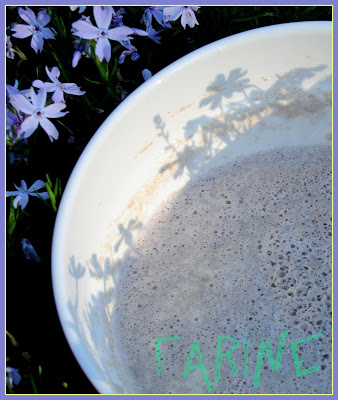
A chickpea levain I once made for a Cretan spiced bread
The baker is thus able to vary the flavor profiles while still using more regular bread flour in the final dough (thus bringing some of the strength back to it). It certainly works very well taste-wise. While at SFBI, I sampled many breads made with specialty flour preferments – as then student Safa Hemzé was experimenting with various flours – and the range of flavors was enormous. For an article on Safa’s work, click here.
The pictures below were taken by me at SFBI in January during an informal bread tasting session. The breads were all made by Safa.






Although I loved the flavors these various preferments brought to each bread, I don’t think that the nutritional benefits of putting most of the specialty flour in the preferment are quite the same as they would be if more of the ancient grain flour was used in the final dough together with more whole grain flour instead of more regular bread flour.
Using a sourdough starter may even be better than just using a poolish or a sponge. Whitley goes on to write in another chapter, “lactic acid bacteria play a part in neutralising substances in wheat flour that can limit nutrient availability to human consumers”.
He explains that “the bran contains considerable amount of phytic acid, which inhibits the absorption of these valuable minerals and trace elements” and that, according to a recent French study, “the action of lactic acid bacteria in sourdough fermentations improves the nutritional quality of wheat bread by reducing the amount of phytate” whereas “simple fermentation with yeast produced less than half the quantity of soluble (available) magnesium at the end of a four-hour period compared with the sourdough”.
So far so good! We have the great taste and some nutritional benefits (the nutrients present in the specialty and/or whole flour plus the outcome of the chemical activity at work in the prefermentation), but can we do better?
After all, as Beatrice Ojakangas puts it in Great Whole Grain Breads, a well-documented book first published in 1984 which is full of interesting and out-of-the-ordinary recipes, “bulk for bulk, whole grain breads have about half the calories of traditional breads, supply the most preferable plant protein, and offer valuable fiber to the diet”.
Couldn’t we have our whole grain and specialty flour flavors and eat them too?
I don’t know but I mean to try and find some answers.
You know how some passionate cooks or bakers set themselves challenges, like making of all the recipes in Mastering the Art of French Cooking or baking all of the bread formulas in the Bread Maker’s Apprentice? Well, since I’d like to find out whether or not other techniques would make it possible to use more whole grains in more delicious breads, the (limited, I’ll admit it) challenge I am setting to myself is to try and master the master formula detailed by Peter Reinhart in Whole Grain Breads.
Why this particular one?
- Because my first brush with that technique was with a derivative method developed by Nancy Baggett in Kneadlessly Simple (a book I reviewed here). I used it to make a 100% whole wheat loaf and I never made or ate a better 100% whole wheat bread (for some info on my experience making that bread, click here and go to bottom of post); Baggett acknowledges her debt to Reinhart, so I’d like to see what Reinhart’s original idea was;
- Because we liked what I have already baked from the Reinhart’s book, such as the 100 % whole grain multigrain baguettes and I wouldn’t mind getting a firm foundation as to the technique before trying my hand at some of his other recipes (although one of his mashes and his whole wheat levain are sitting on the kitchen counter right now, waiting to be made into one of his mash breads) but I am pretty much proceeding by trial-and-error with that bread since it is a mixture of his ideas and my own and I’d like to be more methodical;
- Because although I adore crunchy, chewy, holey-crumby baguettes and many other mostly white breads, I also love dense loaves (so does my son-in-law, so that makes two of us), a taste that isn’t not always shared by my under-20 descendants. I wouldn’t mind seducing their palate with other flours in such a way that they wouldn’t even realize they were eating “healthfully”, a word which, for whatever reason, seems less than compelling to their young ears… And I’ll be the first to admit that it is absolutely useless to put more “good-for-you” flours in the bread if it doesn’t get eaten;
- Because my eyes have a tendency to glaze over when I try to read the 75 pages or so that lead up to the master formula in Reinhard’s book and because I have yet to follow any recipe faithfully. I’ll have to if I want to master the technique. So I will both read the introduction as carefully as Reinhart begs us to (and I will try not to do that at night when nap attacks are more likely) and follow his instructions to the letter. That’s the promise and the challenge.
As I am currently on an assignment (nothing to do with bread, alas), I can’t promise it will be immediate and even hesitate to set a timeframe. But I promise that it will happen and that I will keep you posted. Meanwhile I’ll keep on baking in my spare time ! Please share your thoughts with me as to the quandary between better taste and better nutrition.



























